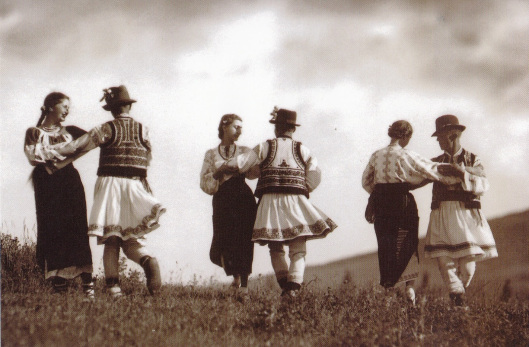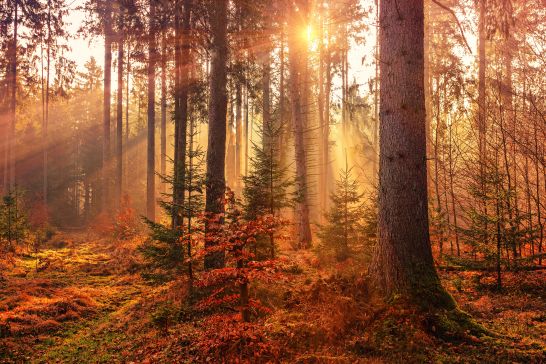Sumedru’s Sacred Fires mark the beginning of pastoral winter and you can see them dancing in the heart of the night if you travel through the southwest of Romania, namely Oltenia or western Wallachia.
I remember them, sprinkled along the valleys like bursts of sacred light in the darkest of nights. „Come to Sumedru’s fire” would echo far, a chant none can escape from, the desire to be part of creating such sacred fires rising from a ripple of curiosity to the full force of knowing that you’re joining a tradition that survived millennia, and marking the end of a bountiful fall and the beginning of the pastoral winter, the passing of time – your time.
Any Sumedru’s fire (or Sâmedru’s) starts with the lads who chase one another up, up the top of the hills, waking up stones in their rush, till they reach the line of fir trees – where beasts loom in winter. There, the lads begin tearing branches, the ones they can reach, then cleaning them of needles, their small hands soon stained with resin, green pins stuck in their old shirts, the smell of a day’s labour washed by the sweet and vinegary scent of the fir, sweet and strong.

The cleaned branches soon turn to armfuls, among shouts and laughter, the armfuls become piles, the heaps are tied together and dragged, or rolled – by the lad’s strength -to carts pulled by six horses, Dacian horses, strong and sturdy, and a lad on top.
All this, while the tiny lads, the ones just a tad bigger than a piglet, grab at their own fir branch, hoist it on their callow shoulders, and take it down the valley. Some would fall on the slippery, treacherous path, scrape their knees, rub a sleeve under their noses, and pick themselves up while holding tight to their prized possession, the fir branch.
Oh, they would fight too, now and then, the lads with the carts and the tiny lads on foot. But in the end, all the fir branches are piled together in the valley below, and the lads cheer and whistle, laugh, and clap one another on the back for a job well done.
It isn’t over yet.
More arrive, seven or eight, relatives and friends bringing together one single fir tree, whole, and as tall as a church steeple. This one tree is buried in a hole already dug into the ground. They pile around kindling, sticks, tinder, and logs to make embers, the branches carried down, and on top, they stuff the resin brought in their pockets.
About now the bells ring in the village for the evening mass and their echoes carry over the fields, and to the lads gathered around the tree.
It is time.
There is a hum in the air, a jolt of excitement, of fear too, of pent-up energy, and not only from the fir branches and the kindle, but from the lads, from the ground they stomped on, from the fir trees still standing atop the hill, from the birds tucked in the trees, and the stars above, knowing, waiting.
Then all eyes turn.
A lad, small but sturdy, had the candle. He holds it in his hand his dusty, stained face aglow in the warm light. Then he lifts his hand, “wow”, hum the others, “wow”, carries over the valley and all, everything holds its breath. Till the small and sturdy lad lifts his arms, lifts himself on his tiptoes, and then thrusts his arm backward and forward like a gale of wind, like a whoosh of a torrent, like the passing of time… and throws the candle, the half piece of wax modeled around a string, still soft, still translucent, still carrying the prints of the small hand with sort fingers, still scented with milk…
But he’s sturdy, he’s willing and focused on his task. He can feel everyone’s eyes upon him, through the blue darkness that descended on the valley, the sun only a purple glow behind the hill, the first stars out, but not strong yet, like him. So he does a good job. Then holds his breath.
The candle falls between sticks and tinder, and only a trickle of smoke comes out, like a spirit released from the body of the woodpile… then, just as quietly, the tongue of fire rush out, here and there, chasing the air and searching, like the tongues of a dragon, for a pray to catch, and eat.
Everyone cheers, and shouts, and jumps. The lad’s shoulders are clapped by all. Small tears glow in his eyes. The fire burns, stronger and stronger. He’s done it. He lit the fire. He’s a big boy now. Taller, too. And he’s hungry.

Ahead, the flames reached high. The tip of the fir tree twists, once, like the head of a snake caught by the neck. A shower of red needles jumps around, the lads yell, exclaim, and pull back like one, their eyes caught by the flame’s enchantment, their faces red with light and the heat, with the exertion of their creation.
The fire tree’s head bows, defeated. But the fire goes on and on. The higher it is, the better the new year will be. Fire is the projection of the Sun on earth, a sacred symbol of vital energy, and of the heart, of the power of conception.
“Come to Sumedru’s Fire!” the valley erupts.
And the tree burns, and burns, and burns, consumed.
The women all join the crown of lads. They bring bagels, still warm from the oven, crunchy on the top, soft like a mother’s heart inside. They bring nuts, by the bag-full, mild and earthly walnuts with a tangy aftertaste. They bring apples, the autumn’s bounty, crunchy and juicy with a voice of their own when you bite in, crunch, sweet juice dripping on the chin, asking for a piece of walnut to complete the taste.
And they bring round, sweet bagels brushed with honey.
The lads eat and ask for more, the women laugh and give them handfuls and, among all, the voices call, again and again, “Come to Sumedru’s Fire!”
Is the shout that rips through the night calling everyone to fulfill the tradition. The Sumedru’s dance begins, like a circular, solar dance that opens the great party marking everyone’s entry into the pastoral winter.
The fir tree is Romanian’s sacred tree, present in all the rites of passage. In Romanian spirituality, the fir tree governs the entire life of a peasant: the birth, the wedding, the funeral, his entire lifestyle: the altar tree, the confessional tree, or the cosmic, Christmas tree – a true cosmic axis that connects earth and sky.
The fir tree burns into the night until all the stars shine bright, and the fir tree is but kindles. Now, the children jump over them to stay healthy in the New Year, and the lads jump to be lucky and get married. The maidens wish, and pray upon them:
“As sparks jump from embers,
so my beloved’s heart may sparkle”
One last hora, one last dance, while the fire burns all out. Then the lads go and fetch water to kill the last of the kindles. The wind is but a wisp, but the wind is sneaky, much like the fire.

The men are tired, lads and women too, ready to return home. But not before looking at the moon, just up, from behind the hill. If the moon s full and the sky is clear, the winter will be a good one. But if clouds pull in front of the moon, or if it rains, then the winter will be cold, and harsh.
In some villages bonfires are lit at crossroads, at the borders of the village, on the banks of rivers, as well as in all the places where evil spirits might dwell. There is a belief that the heaven opens its gates at Sumedru and the souls of the deceased return home, some of them being able to transform into the undead, the moroi, or the werewolves. The Sumedru’s fires have, thus, a protective and purifying power, as is the food offering done at church on the Saturday before the Sumedru holiday.
You better pay back all your debt by Sumedru’s day, or the next year you will struggle.
For pastoral communities, the night of October 25 had the significance that New Year’s Eve has for us. It marks a landmark between the two pastoral seasons, a holiday celebrating the death and rebirth of Sumedru / Sâmedru, a deity of Indo-European origin and protector of the herdsmen.
It is said that Sumedru (St. Demetrius) marks not only the beginning of the hibernal season but also the beginning of the New Year. Together with Sângiorz (St. George), his brother, they divide the pastoral year into two seasons: winter and summer.
On October 26, Sumedru received the keys from Sângiorz’s hand , then with great haste, he closed the mild weather with one key and opened the cold winter with the other. Both brothers wore the keys of the weather at their waists, lest someone tries to steal them from the doors of the seasons and play with the weather as they please.
After they exchanged the keys of time, the saints depart, one to the right and the other to the left, moving six months apart from each other.
That’s what the folk legend says.
sâmédru s.m. (pop.) is the name of the Christian holiday of St. Demetrius celebrated on October 26th
For tales inspired by Romania’s folklore and traditions, but it rich history too, you could read my latest book release, Dreamland:



Beautiful descriptions and photos in this post.
Thank you, Vanya 🙂 I am so glad that you enjoyed this whimsical journey 😉